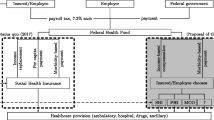Abstract
Background
Game theory is useful for identifying conditions under which individual stakeholders in a collective action problem interact in ways that are more cooperative and in the best interest of the collective. The literature applying game theory to healthcare markets predicts that when providers set prices for services autonomously and in a noncooperative fashion, the market will be susceptible to ongoing price inflation.
Objectives
We compare the traditional fee-for-service pricing framework with an alternative framework involving modified doctor, hospital and insurer pricing and incentive strategies. While the fee-for-service framework generally allows providers to set prices autonomously, the alternative framework constrains providers to interact more cooperatively.
Methods
We use community-level provider and insurer data to compare provider and insurer costs and patient wellness under the traditional and modified pricing frameworks. The alternative pricing framework assumes (i) providers agree to manage all outpatient claims; (ii) the insurer agrees to manage all inpatient clams; and (iii) insurance premiums are tied to patients’ healthy behaviours.
Results and Conclusions
Consistent with game theory predictions, the more cooperative alternative pricing framework benefits all parties by producing substantially lower administrative costs along with higher profit margins for the providers and the insurer. With insurance premiums tied to consumers’ risk-reducing behaviours, the cost of insurance likewise decreases for both the consumer and the insurer.



Similar content being viewed by others
References
Auerbach DI, Kellermann AL. A decade of healthcare cost growth has wiped out real income gains for an average U.S. family. Health Affair. 2011;30(9):1630–6.
Gaynor M, Haas-Wilson D, Vogt W. Are invisible hands good hands? Moral hazard, competition, and the second-best in healthcare markets. J Polit Econ. 2000;108:992–1005.
Zeckhauser R. Medical insurance: a case study of the tradeoff between risk spreading and appropriate incentives. J Econ Theory. 1970;2:10–26.
Laugesen MJ, Glied SA. Higher fees paid to U.S. physicians drive higher spending for physician services compared to other countries. Health Affair. 2011;30(9):1647–56.
Gruber J. Covering the uninsured in the United States. J Econ Lit. 2008;46(3):571–606.
Thorpe KE, Yang Z. Enrolling people with prediabetes ages 60–64 in a proven weight loss program could save Medicare $7 billion or more. Health Affair. 2011;30(9):1673–9.
Braveman PA, Egerter SA. Overcoming obstacles to health. Report from the Robert Wood Johnson Foundation to the Commission to Build a Healthier America. Princeton (NJ): Robert Wood Johnson Foundation, 2008 [online]. Available from URL: http://www.rwjf.org/en/research-publications/find-rwjf-research/2008/02/overcoming-obstacles-to-health.html [Accessed 2012 Jan 31].
Roehrig CS, Rousseau DM. The growth in cost per case explains far more of U.S. health spending increases than rising disease prevalence. Health Affair. 2011;30(9):1657–63.
Thomas LC. Games, theory and applications. New York (NY): Wiley; 1984.
Feldstein MS. The rising price of physicians’ services. Rev Econ Stat. 1970;52:121–33.
Chiu WH. Health insurance and the welfare of healthcare consumers. J Public Econ. 1997;64:125–33.
Vaithianathan R. Will subsidizing private health insurance help the public health system? Econ Rec. 2002;78(242):277–83.
Vaithianathan R. Health insurance and imperfect competition in the healthcare market. J Health Econ. 2006;25:1193–202.
Damianov DS, Pagan JA. Health insurance coverage, income distribution and healthcare quality in local healthcare markets [mimeo]. Edinburg (TX): University of Texas, Pan American, Department of Economics and Finance; 2010.
Wright DJ. Insurance and monopoly power in a mixed private/public hospital system. Econ Rec. 2006;82(259):460–8.
Tirole J. The theory of industrial organization. Cambridge (MA): MIT Press; 1990.
Altoona Regional Health System, Altoona (PA). Annual financial report [online]. Available from URL: http://altoonaregional.org/exceptional/pdf/annualfinancialreport.pdf [Accessed 2012 Jan 31].
Pennsylvania Insurance Department. Highmark and subsidiaries: financial statements [online]. Available from URL: http://www.portal.state.pa.us/portal/server.pt/community/industry_activity/9276/highmark_subisdiaries_-_financial_statements/1036076. [Accessed 2012 Jan 31].
Kaiser Family Foundation and Health Research & Educational Trust. Employer health benefits: Study number 8085 [online]. Available from URL: http://ehbs.kff.org/pdf/2010/8085.pdf [Accessed 2012 Jan 31].
The Wellness Counsels of America (WELCOA). The cost benefit of worksite wellness [online]. Available from URL: http://www.welcoa.org/worksite_cost_benefit.html [Accessed 2012 Jan 31].
PricewaterhouseCoopers, Factors Fueling Rising Healthcare Costs 2008 [online]. Available from URL: http://www.google.com/url?sa=t&rct=j&q=pricewaterhousecoopers%20factors%20fueling%20rising%20healthcare%20costs&source=web&cd=1&cad=rja&ved=0CCwQFjAA&url=http%3A%2F%2Fwww.ahip.org%2FuploadedFiles%2FContent%2FNews%2FPress_Room%2F2008%2FResources%2FTheFactorsFuelingRisingHealthcareCosts2008.pdf&ei=PCmzUMC6GOTE4gTBzYDwBQ&usg=AFQjCNFUg-OO-9fZaJu0LHl28CcSFFNoRA [Accessed 2012 Jan 31].
Hing E, Burt CW. Characteristics of office-based physicians and their practices: United States. Hyattsville (MD): National Center for Health Statistics, 2007;13(164):1–34.
Hing E, Cherry DK, Woodwell DA. National ambulatory medical care survey: 2004 summary. Adv Data. 2006;374:1–33.
Jackson Healthcare, LLC. Physician compensation source survey [online]. Available from URL: http://www.jacksonhealthcare.com/media-room/surveys/physician-compensation-survey-fixed-vs-variable-sources.aspx [Accessed 2012 Jan 31].
Cox T. Legal and ethical implications of healthcare provider insurance risk assumption. JONAS Healthcare Law Ethics Regul. 2010;12(4):106–16.
Cox T. Exposing the true risks of capitation financed healthcare. J Healthcare Risk Manag. 2011;30:34–41.
Miller HD. From volume to value: better ways to pay for healthcare. Health Affair. 2009;28(5):1418–28.
Jensen E, Mendonca L. Why America spends more on health care. Washington (DC): National Institute for Health Care Management, 2009 [online]. Available from URL: http://www.nihcm.org [Accessed 2012 May 25].
Terry K. Has capitation reached its high-water mark? Medical Econ. 2001;4:32.
Reeder G. Wellness-based healthcare: economic incentives and benefit design. Am Health Drug Benefits 2010; 3(2, Suppl 6):S98–S10.
Acknowledgements
The authors gratefully acknowledge helpful comments and suggestions from two anonymous reviewers. The authors also thank Val Mignogia, Mainline Medical Associates; Charles Zorger, Altoona Regional Health System; and Patrick Reilly, Highmark Blue Shield for provision of data. No sources of funding were used to conduct this study or to prepare this manuscript. The authors have no conflicts of interest that are directly relevant to the content of this study. Drs. Gates and Agee contributed equal efforts to the research and writing of the manuscript. Both authors controlled the decision to write and to submit the manuscript for publication and approved the final version. Dr. Gates is the guarantor for the overall content of the paper.
Author information
Authors and Affiliations
Corresponding author
Rights and permissions
About this article
Cite this article
Agee, M.D., Gates, Z. Lessons from Game Theory about Healthcare System Price Inflation. Appl Health Econ Health Policy 11, 45–51 (2013). https://doi.org/10.1007/s40258-012-0003-z
Published:
Issue Date:
DOI: https://doi.org/10.1007/s40258-012-0003-z




